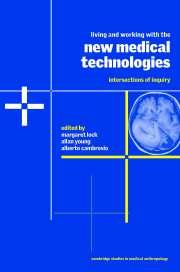Book contents
- Frontmatter
- Contents
- List of contributors
- 1 Introduction
- Part I Epochal transitions? Biomedicine and the transformation of socionature
- Part II Laboratories and clinics: the material cultures of biomedicine
- Part III Technologies and bodies: the extended networks of biomedicine
- 8 Screening the body: the pap smear and the mammogram
- 9 Extra chromosomes and blue tulips: medico-familial interpretations
- 10 When explanations rest: “good-enough” brain science and the new socio-medical disorders
- 11 On dying twice: culture, technology and the determination of death
- 12 The practice of organ transplants: networks, documents, translations
- Index
10 - When explanations rest: “good-enough” brain science and the new socio-medical disorders
Published online by Cambridge University Press: 23 December 2009
- Frontmatter
- Contents
- List of contributors
- 1 Introduction
- Part I Epochal transitions? Biomedicine and the transformation of socionature
- Part II Laboratories and clinics: the material cultures of biomedicine
- Part III Technologies and bodies: the extended networks of biomedicine
- 8 Screening the body: the pap smear and the mammogram
- 9 Extra chromosomes and blue tulips: medico-familial interpretations
- 10 When explanations rest: “good-enough” brain science and the new socio-medical disorders
- 11 On dying twice: culture, technology and the determination of death
- 12 The practice of organ transplants: networks, documents, translations
- Index
Summary
Explanations come to an end somewhere.
(Wittgenstein 1972 [1953]: 1)Wittgenstein's opening to Philosophical Investigations points to a fundamental crisis in scientific and medical research: When is there enough explanation of a phenomenon to consider it settled and definable? If a cluster of symptoms – say dizziness, itching, extreme fatigue and weakness – afflicts a group of persons working together, what kind of explanation is good enough? Is finding a food they all ate, or common exposure to a rare gas, or a common brain pattern enough to say, “Okay, that is it”? Or is locating a certain gene they all share, or a drug that relieves some of the symptoms enough? What if only four out of five share the characteristic? Or yet again, do we need the entire pathophysiology of each symptom?
The fact that different people answer these questions differently points to the social location of these questions. The very meaning of “definable illness” and especially the entailments of that definition – whether a person with symptoms receives help or blame or dismissal – depend upon who is doing the assessing, where they are doing it from, and within what regime of social good and compassion they are operating. We may not like the implication that a person is sick in one place but not in another, but socially this may be a fact.
In this paper I begin an ethnographic characterization of what is shared across a set of contested fields I call the new socio-medical disorders.
- Type
- Chapter
- Information
- Living and Working with the New Medical TechnologiesIntersections of Inquiry, pp. 209 - 232Publisher: Cambridge University PressPrint publication year: 2000
- 59
- Cited by



